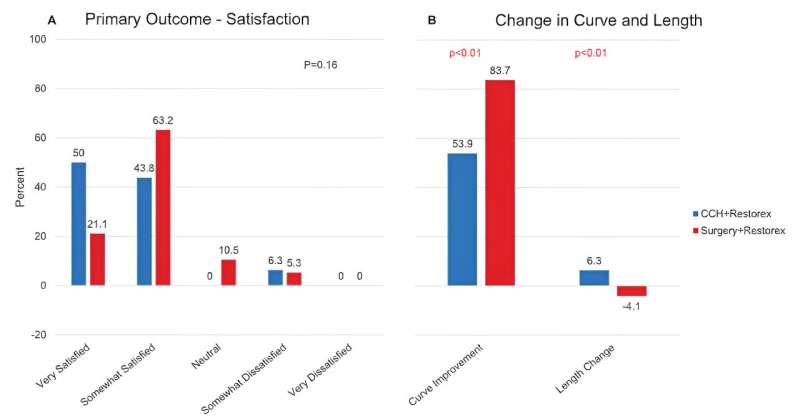This article has been reviewed according to Science X's editorial process and policies. Editors have highlighted the following attributes while ensuring the content's credibility:
fact-checked
peer-reviewed publication
trusted source
proofread
Nonsurgical treatment shows advantages in Peyronie's disease

For men with Peyronie's disease (PD), nonsurgical treatment including injections of collagenase clostridium histolyticum (CCH) produces high satisfaction with sexual outcomes—with fewer adverse events compared to surgery. These are the results of a clinical trial reported in the October issue of the Journal of Urology.
"Our findings provide new evidence to facilitate discussion and decision-making about treatment options for men with PD," comments senior author Landon Trost, MD, of Male Fertility and Peyronie's Clinic in Orem, Utah.
Randomized trial compares CCH injections with surgery for PD
Peyronie's disease is a condition in which the penis becomes curved due to scar-like tissue called plaque, resulting from an abnormal healing response after injury. Especially in severe cases, the curvature may make it difficult or impossible to have sex. Some men may experience pain or erectile dysfunction.
Surgery has long been the standard treatment for PD. In 2014, the US Food and Drug Administration approved CCH as a nonsurgical alternative. Treatment includes injections of CCH, with the aim of breaking down the plaque tissue causing the penile curvature. To better understand the relative advantages and disadvantages of the treatment alternatives, Dr. Trost and colleagues performed a clinical trial to compare CCH and surgery.
Forty men with PD were randomly assigned to CCH injection therapy or surgery. Nonsurgical treatment included CCH injections, followed by the use of a traction device (RestoreX) to help stretch and shape the penis plus the oral medication sildenafil. Most patients underwent multiple courses of CCH treatment.
Men assigned to surgical treatment underwent appropriate surgery to reduce their penile curvature, followed by use of RestoreX traction plus sildenafil. The two groups were balanced in terms of PD severity and similar in other characteristics. Outcomes were assessed in 38 men who completed treatment.
CCH has higher patient satisfaction, fewer adverse effects
After three months, 50% of men assigned to CCH reported being "very satisfied" with their outcomes, compared to 21% in the surgery group. Men in the CCH group also reported better erectile function: 100% versus 68%. However, scores on a standard erectile function score were similar between groups.
Men undergoing surgery had greater improvement in penile curvature: 65 degrees, compared to 32.5 degrees in the CCH group. Penile length increased by an average of one centimeter with CCH injections, compared to a one-half centimeter reduction with surgery.
Orgasmic function was better in men assigned to CCH; most other subjective outcomes were similar between groups. Adverse event rates were higher in the surgery group: four times higher overall than with CCH.
The study is "the first of its kind to compare multiple key outcomes between contemporary gold-standard therapies for PD," Dr. Trost and colleagues write. Although surgery produces greater improvement in penile curvature, sexual function and overall patient satisfaction appear higher with CCH injection therapy.
The authors note some limitations of their study, including short-term follow-up in a relatively small number of patients. Dr. Trost comments, "Rather than showing an advantage of one approach over the other, we hope our study will provide useful new data to inform discussions and decision-making, aimed at choosing the most appropriate treatment for each individual patient."
More information: Benjamin Green et al, Comparison of Collagenase Clostridium histolyticum to Surgery for the Management of Peyronie's Disease: A Randomized Trial, Journal of Urology (2023). DOI: 10.1097/JU.0000000000003634
















